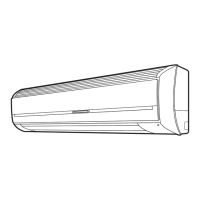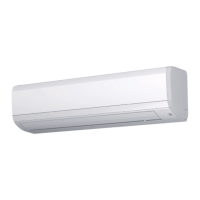Piping connections
The outdoor condensing unit must be connected to the
indoor evaporator coil using field-supplied refrigerant
grade (ACR) copper tubing that is internally clean and
dry. Units must be installed only with the tubing sizes for
approved system combinations as specified in the Tabular
Data Sheet. The charge given is applicable for total tubing
lengths up to 15 ft (4.6 m). Refer to the Piping Application
Guide (P/N 24077) for installing tubing of longer lengths
and elevation differences.
NOTICE
Using a larger than specified line size could result
in oil return problems. Using too small a line results
in loss of capacity and other problems caused by
insufficient refrigerant flow. Slope horizontal vapor
lines at least 1 in. (2.5 cm) every 20 ft (6.1 m) toward
the outdoor unit to facilitate adequate oil return. If
more than the 80 ft line length is necessary, facilitate
correct refrigerant velocity with adjusted line diameter
in accordance with the Piping Application Guide (P/N
24077).
CAUTION
This system uses R-410A refrigerant, which operates
at higher pressures than R-22. No other refrigerant
may be used in this system. Gauge sets, hoses,
refrigerant containers, and the recovery system must
be designed to handle R-410A. If you are unsure,
consult the equipment manufacturer.
WARNING
Never install a suction-line filter-drier in the liquid line
of an R-410A system. Failure to follow this warning
can cause a fire, injury or death.
Precautions during line installation
• Install the lines with as few bends as possible. Be
careful not to damage the couplings or kink the
tubing. Use clean hard drawn copper tubing where no
appreciable amount of bending around obstruction is
necessary. If soft copper must be used, be careful to
avoid sharp bends, which may cause a restriction.
• Install the lines so that they do not obstruct service
access to the coil, air handling system, or filter.
• Isolate the refrigerant lines to minimize noise
transmission from the equipment to the structure.
• Insulate the vapor line with a minimum of 3/8 in.
foam rubber insulation (Armaflex or equivalent).
Also insulate liquid lines that are exposed to direct
sunlight, high temperatures, or excessive humidity.
• Tape and suspend the refrigerant lines as shown in
Figure 5. Do not allow tube metal-to-metal contact.
• Use PVC piping as a conduit for all underground
installations as shown in Figure 6. Keep buried lines
as short as possible to minimize the build up of liquid
refrigerant in the vapor line during long periods of
shutdown.
Figure 5: Installation of vapor line
Figure 6: Underground installation
• Pack fiberglass insulation and a sealing material such
as permagum around refrigerant lines where they
penetrate a wall to reduce vibration and to retain
some flexibility.
• For systems with total line length exceeding 75 ft
(22.86 m), refer to the Piping Application Guide (P/
N 24077) for vapor and liquid line sizing, calibration
of liquid line pressure loss or gain, determination
of vapor line velocity, elevation limitations, TXV
connections, system charging or traps.
Precautions during brazing of lines
All outdoor unit and indoor coil connections are copper-
to-copper and must be brazed with a phosphorous-
copper alloy material such as Silfos-5 or equivalent. Do
not use soft solder. The outdoor units have reusable
service valves on both the liquid and vapor connections.
The total system refrigerant charge is retained within
Installation Manual: R-410A Outdoor Split-System Air Conditioner 9
Johnson Controls Ducted Systems

